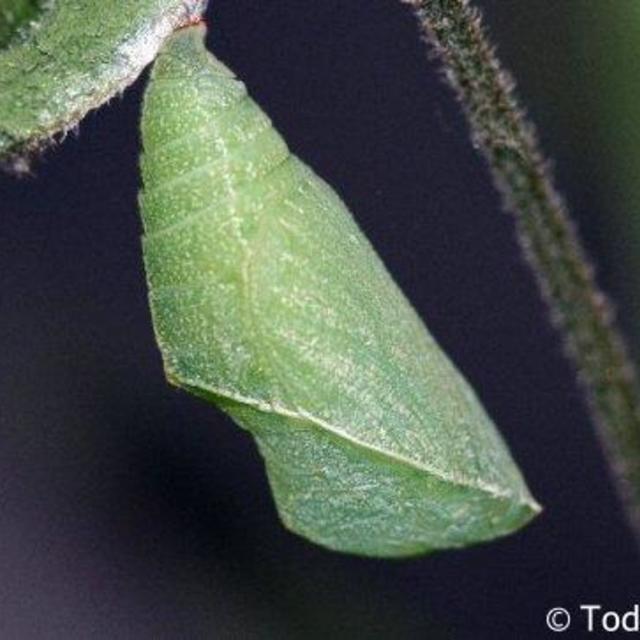American Snout
Libytheana carinenta (Cramer, 1777)
Family: Nymphalidae
Subfamily: Libytheinae
Identification: Labial palps long and extended forward. Tip of forewing squared off. Upperside brown, forewing with orange at base and inner margin, and white spots on outer half. Underside of hindwing mottled or smooth violet-gray.
Wing Span: 1 3/8 - 2 inches (3.5 - 5 cm).
Life History: Adults perch on branches and imitate dead leaves by holding palps and antennae downward to look like petioles. Males patrol near host plants to seek females. Eggs are laid in small groups on leaves of the host tree; caterpillars eat young leaves. Adults overwinter in the southern part of their range.
Flight: Two broods; May-June, and August. These butterflies sometimes undertake huge migrations.
Caterpillar Hosts: Several species of hackberry (Celtis).
Adult Food: Nectar from flowers of aster, dogbane, dogwood, goldenrod, sweet pepperbush, and others.
Habitat: Forest clearings and edges, thorn scrub, brushy fields, roadsides.
Range: Argentina north through Mexico and the West Indies to southern United States. Migrates to central California, southern Nevada, Colorado, and most of the eastern United States.
Conservation: Not usually of concern.
NCGR: G5 - Demonstrably secure globally, though it may be quite rare in parts of its range, especially at the periphery.
Management Needs: None reported.
Please donate!
We depend on donations to keep Butterflies and Moths of North America freely available. We want to express our gratitude to all who showed their support by making a contribution this year. You can donate to support this project at any time.
Advertise with us!
Do you have a product or service that you think would interest BAMONA users? If you would like to advertise on this website, contact us by email, or use the contact form and select the "Advertising" category.
Verified Sightings
Displaying 1 - 24 of 3683 verified sightings

Observation date: Nov 14, 2025
Submitted by: Janet Ruth
Region: Sandoval County, New Mexico, United States
Verified by: stevecary
Verified date: Nov 16, 2025

Observation date: Nov 11, 2025
Submitted by: sayornis_lacnm
Region: Los Alamos County, New Mexico, United States
Verified by: stevecary
Verified date: Nov 12, 2025

Observation date: Nov 08, 2025
Submitted by: Chris Tosdevin
Region: Los Angeles County, California, United States
Verified by: Ken Davenport
Verified date: Nov 10, 2025

Observation date: Oct 27, 2025
Submitted by: Robert Gorman
Region: San Bernardino County, California, United States
Verified by: Ken Davenport
Verified date: Nov 10, 2025

Observation date: Nov 03, 2025
Submitted by: topper72
Region: Los Alamos County, New Mexico, United States
Verified by: stevecary
Verified date: Nov 06, 2025

Observation date: Nov 03, 2025
Submitted by: Cactuswren1976
Region: Los Alamos County, New Mexico, United States
Verified by: stevecary
Verified date: Nov 06, 2025

Observation date: Oct 27, 2025
Submitted by: Robert Gorman
Region: San Bernardino County, California, United States
Verified by: Ken Davenport
Verified date: Nov 04, 2025

Observation date: Oct 30, 2025
Submitted by: Bill Uttenweiler
Region: Bexar County, Texas, United States
Verified by: jwileyrains
Verified date: Nov 03, 2025

Observation date: Oct 25, 2025
Submitted by: guy_incognito
Region: San Bernardino County, California, United States
Verified by: Ken Davenport
Verified date: Nov 01, 2025

Observation date: Oct 26, 2025
Submitted by: Naturalista
Region: Santa Fe County, New Mexico, United States
Verified by: stevecary
Verified date: Oct 31, 2025

Observation date: Jul 25, 2025
Submitted by: ButterBelle
Region: Putnam County, Tennessee, United States
Verified by: CA Ivy
Verified date: Oct 24, 2025

Observation date: Aug 09, 2025
Submitted by: tnjbodker
Region: Roane County, Tennessee, United States
Verified by: CA Ivy
Verified date: Oct 24, 2025

Observation date: Aug 12, 2025
Submitted by: Blablancwillis
Region: Douglas County, Kansas, United States
Verified by: jmgesell
Verified date: Oct 24, 2025

Observation date: Aug 13, 2025
Submitted by: ButterBelle
Region: Putnam County, Tennessee, United States
Verified by: CA Ivy
Verified date: Oct 24, 2025

Observation date: Sep 07, 2025
Submitted by: Snellzy
Region: Davidson County, Tennessee, United States
Verified by: CA Ivy
Verified date: Oct 24, 2025

Observation date: Nov 24, 2024
Submitted by: LVSteve
Region: Nuevo Leon, Mexico
Verified by: jwileyrains
Verified date: Oct 22, 2025

Observation date: Sep 09, 2025
Submitted by: naj.pilla
Region: Elkhart County, Indiana, United States
Verified by: jmgesell
Verified date: Oct 19, 2025

Observation date: Aug 24, 2025
Submitted by: TJM321
Region: Texas, Travis County, United States
Verified by: jwileyrains
Verified date: Oct 19, 2025

Observation date: Aug 21, 2025
Submitted by: dchartier
Region: El Paso County, Colorado, United States
Verified by: mikefisher
Verified date: Oct 19, 2025

Observation date: Oct 15, 2025
Submitted by: dchartier
Region: El Paso County, Colorado, United States
Verified by: mikefisher
Verified date: Oct 19, 2025

Observation date: Oct 10, 2025
Submitted by: Cactuswren1976
Region: Santa Fe County, New Mexico, United States
Verified by: stevecary
Verified date: Oct 14, 2025

Observation date: Oct 09, 2025
Submitted by: Dogoszhi
Region: Bernalillo County, New Mexico, United States
Verified by: stevecary
Verified date: Oct 11, 2025

Observation date: Sep 21, 2025
Submitted by: Alison Davies
Region: Richland County, South Carolina, United States
Verified by: Dennis Forsythe
Verified date: Sep 22, 2025

Observation date: Sep 14, 2025
Submitted by: jmgesell
Region: Northampton County, Pennsylvania, United States
Verified by: davidwright
Verified date: Sep 19, 2025
- 1 of 154
- next ›












